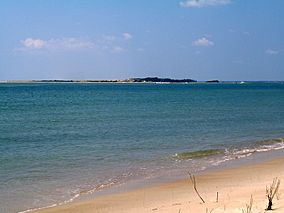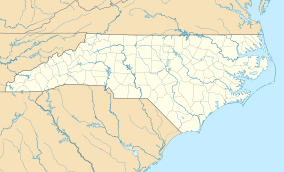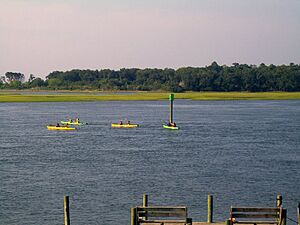Hammocks Beach State Park facts for kids
Quick facts for kids Hammocks Beach State Park |
|
|---|---|
|
IUCN Category III (Natural Monument)
|
|

Bear Island at Hammocks Beach State Park
|
|
| Location | Onslow, North Carolina, United States |
| Area | 1,611 acres (6.52 km2) |
| Elevation | 0 ft (0 m) |
| Established | 1961 |
| Governing body | North Carolina Division of Parks and Recreation |
| Website | Hammocks Beach State Park |
Hammocks Beach State Park is a cool state park in Onslow County, North Carolina. It's located near Swansboro, along the beautiful Southern Outer Banks, also known as the Crystal Coast. This park covers about 1,611 acres (6.52 km2) of land and water. Its main feature is Bear Island, a barrier island. The park also includes three smaller islands: Dudley, Huggins, and Jones. These islands are found near the mouth of the White Oak River. Recently, the park grew even bigger by adding 319 acres (1.29 km2) of land on the mainland.
Contents
Exploring Bear Island
Bear Island is a long island, about four miles in length, with a sunny, south-facing beach. It has many sand dunes and a small area of maritime forest. This forest is a special type of woodland found near the coast. On the northern side, facing the sound, you'll find thick shrubs and marshlands.
Bear Island is a favorite spot for visitors who come for the day. It's also popular with boaters, kayakers, and campers. There's a new bathhouse for convenience and simple camping spots. Most of the island remains wild and untouched. Most animals on the island arrived by flying or swimming across the water. Fresh water is hard to find here, only in a few small ponds. Big storms like hurricanes have changed the beach and dune areas quite a bit.
Getting to Bear Island
A special ferry service takes people from the park's main office on the mainland to Bear Island. The ride goes through a narrow waterway called Cow Channel. Even though the trip is only about 15 minutes, the channel can be tricky to navigate. Since 1996, it has become harder to use the channel at low tide. This is because sand has moved around in the water, especially after several hurricanes.
Sometimes, when the water is very low, the park uses smaller boats to carry passengers. These boats hold 11 people, instead of the usual 28-passenger ferry. In 2007, the ferry service had to stop for a few months. This allowed for an emergency project to dig out the sand in the channel. By 2009, Hammocks Beach State Park had a new ferry that could carry up to 49 passengers.
In 1980, Bear Island was recognized as a National Natural Landmark. This means it's a very special natural place in the country.
Discovering Huggins Island
Huggins Island is located just inland from Bear Island, closer to the mainland. It's mostly covered by a 110-acre (0.45 km2) thick maritime forest. This forest has many large, old live oak trees. The island is mostly flat and doesn't have sand dunes like Bear Island. It's about a quarter the size of Bear Island. On the western end of the island, you can see the town of Swansboro. This area also has a large marsh.
You can only reach Huggins Island by private boat. There are no buildings or facilities on the island. Camping is also not allowed here. Huggins Island became part of Hammocks Beach State Park in the year 2000.
There's an even smaller island nearby, famous for its shark teeth! People call it Sharks Tooth Island because so many shark teeth wash up on its eastern tip. However, this island is not part of Hammocks Beach State Park.
Exploring Jones Island
Jones Island is about seven miles northeast of Bear Island. It sits right in the middle of the White Oak River, about a mile from Swansboro. This makes it a very noticeable piece of land in the lower part of the river.
The island has slightly raised areas at its southeast and northwest ends. Along its eastern shore, you'll find marshes and small ponds. The northwestern part of the island has a special type of forest called a coastal fringe evergreen forest. This kind of ecosystem is quite rare along the coast. You can see loblolly pine and live oak trees growing here. Sometimes, a colorful bird called the eastern painted bunting is seen nesting on the island. These sparrow-sized birds are rare in North Carolina.
In October 2007, 17 acres (0.069 km2) of Jones Island officially became part of Hammocks Beach State Park. This island is considered a very important natural area. It was once planned for houses, but now it will be protected for many years to come.
Dudley Island
Dudley Island is located between Bear Island and Huggins Island. This island was given to the state as a gift. The state received the first part of this gift in December 2015. The full donation will happen over three years.
Park History
Long ago, Native Americans used dugout canoes to travel the coastal waterways. They journeyed between the mainland and the islands. These Native Americans were involved in conflicts with early colonists in the 1700s. They sometimes hid around Bear Island.
Later, pirate ships sailed these waters. The hidden inlets and shallow waterways behind the islands were perfect places for pirates to hide. They could attack merchant ships and repair their own vessels here. One famous pirate who visited this area was Blackbeard. Spanish privateers (like pirates, but with government permission) also caused trouble for the colonists. To protect themselves, the colonists built forts. One fort was built near Bear Inlet in 1749, but it's gone now.
Islands in Conflict
Bear Island and Huggins Island have often played a role in protecting the mainland. During the Civil War, Confederate soldiers on Bear Island defended it. Huggins Island was also important during the Civil War. A fort was built on Huggins Island in 1861 to protect the area. Local enslaved people and soldiers helped build it. Cannons were placed there to guard the inlet.
Later, Union forces attacked the area. In August 1862, a Union group explored Swansboro. During this trip, they burned the fort on Huggins Island. Only the earthen walls of the fort remained. These old earthworks are still there today. They are the only untouched examples of Confederate forts left on the North Carolina coast.
During World War II, the Coast Guard used Bear Island. They watched the coast and looked for German submarines.
A Park for Everyone
In the early 1900s, Dr. William Sharpe, a doctor from New York, loved to hunt on Bear Island. He bought the island, planning to give it to his friend and hunting guide, John Hurst. But Hurst convinced him to donate it to the North Carolina Teachers Association. This group was made up of African American teachers.
In 1950, the teachers' group owned Bear Island. They tried to build on the island, but it was hard because they didn't have much money and the island was far away. In 1961, the association gave the island to the state of North Carolina to become a park. Hammocks Beach State Park was first planned as a park for minorities. But after the Civil Rights Act of 1964, it opened for everyone to enjoy.
Nearby State Parks
These state parks are within 30 miles (48 km) of Hammocks Beach State Park:
| Preceded by Emerald Isle |
Beaches of Southeastern North Carolina |
Succeeded by Onslow Beach |




